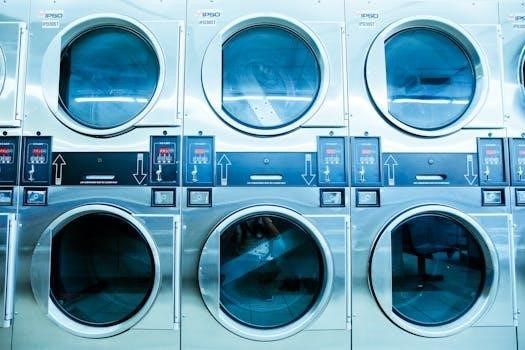GE self-cleaning ovens utilize high temperatures to eliminate interior messes. This feature locks the door for safety. It is designed to simplify oven maintenance, making cleaning a hands-off process using heat to burn away spills and food residue.
Understanding the Self-Clean Feature
The self-clean feature on GE ovens employs extremely high temperatures to incinerate food residue and spills. This process turns the grime into ash, making it easy to wipe away after the cycle completes. During self-clean, the oven door automatically locks for safety, preventing accidental opening. It’s a convenient way to maintain a clean oven interior without the need for harsh chemicals or scrubbing. Remember to remove racks, except enameled ones, before starting.
Preparing Your GE Oven for Self-Cleaning
Before initiating the self-clean cycle, ensure the oven is empty. Remove all items, including cookware and racks, except for enameled ones. Wipe up any significant spills or residue.
Removing Oven Contents
Prior to starting the self-cleaning process, it’s crucial to completely empty your GE oven. This includes removing all baking pans, cooking stones, and any other cookware. Be sure to also take out any oven liners or aluminum foil. Most importantly, remove all the racks unless they are specifically the dark-colored enameled type, as standard racks can be damaged by the high heat of the self-clean cycle. Check your specific model’s manual for clarification.
Wiping Excess Spills and Residue
Before initiating the self-clean cycle on your GE oven, it is essential to wipe away any significant spills or residue. This step prevents excessive smoke and potential staining. Use a damp cloth to remove loose debris, grease, and food particles from the oven’s interior surfaces, including the bottom and sides. Pay special attention to the oven window, as baked-on grime can become difficult to remove if not addressed before self-cleaning. Avoid moving or bending the door gasket when cleaning.
Initiating the Self-Clean Cycle
To begin the self-cleaning process, locate the appropriate control on your GE oven. This is typically labeled “Self Clean” or “Auto Clean”. Then, you will need to set the desired clean time.
Locating the Self-Clean Control
The self-clean control on your GE oven is usually a clearly marked button or pad on the control panel. Look for labels like “Self Clean” or “Auto Clean”. Some models might have a digital display where you select the clean function from a menu. It’s important to consult your specific oven’s user manual for precise location and identification, as control layouts can vary between different GE models.
Setting the Clean Time
After locating the self-clean control, you’ll need to set the cleaning duration. GE ovens often have preset cleaning times, such as 3 hours, which may be adjustable. You can often modify the cleaning time using the plus or minus buttons until your desired time is displayed. Some models might offer low, medium, and high settings, representing different durations. Refer to your user manual for specific instructions on setting the cleaning time.
Safety Precautions During Self-Cleaning
During the self-clean cycle, the oven gets extremely hot. Ensure children and pets are supervised and kept away. Avoid touching the oven exterior, and be aware of the door locking mechanism.
Door Locking Mechanism
The door locking mechanism is a critical safety feature of GE self-cleaning ovens. It automatically engages at the start of the self-clean cycle, preventing the door from opening while the oven is at extremely high temperatures. This safety lock remains active throughout the cleaning process. Do not try to force it open. Wait until the cycle has finished and the oven has cooled down sufficiently, then it will automatically release, allowing you to access the oven interior.
Avoiding Contact with Hot Surfaces
During the self-cleaning cycle, the exterior surfaces of a GE oven, including the door and surrounding areas, become extremely hot. Avoid touching any part of the oven during this process to prevent burns. It is crucial to maintain a safe distance. Do not lean on it or place anything on the exterior that could melt or be damaged by heat. Exercise caution until the oven has cooled down completely following the self-cleaning cycle.
Supervising Children and Pets
It is imperative to keep children and pets away from the GE oven when it is in self-clean mode due to the high temperatures. The exterior of the oven gets extremely hot, posing a burn risk. Children should not be left unattended near the oven during this time. Pets should be kept at a safe distance. Prevent any accidental contact with the hot surfaces to ensure their safety. Always supervise their proximity.

Post Self-Clean Cycle Procedures
After the self-clean cycle, allow the oven to cool completely. Then, wipe away any remaining ash from the interior. This ensures the oven is ready for future use and clean.
Cooling Down Period
Following the completion of the self-clean cycle, it is imperative to allow the oven to cool down completely before attempting to open the door or touch any interior surfaces. The oven will remain very hot and could cause burns. Do not try to open the door by force if it is locked. Wait for the oven lock mechanism to disengage on its own as it cools; This cooling period is a crucial safety measure.
Cleaning Remaining Ash
After the oven has fully cooled, a small amount of ash may remain inside the oven. This is a normal byproduct of the self-cleaning process. Use a damp cloth or sponge to gently wipe away any remaining ash or residue from the oven interior. Avoid using abrasive cleaners or scrub pads, as they could scratch the oven surface, especially on self-cleaning models with ceramic coatings, which may require just a wet cloth.

Additional Tips and Considerations
Consider using gentle cleaners like Bar Keepers Friend or a vinegar and baking soda solution. Always remove these cleaners after use. Avoid harsh chemicals and abrasive materials to protect your oven’s surfaces.
Cleaning the Oven Door and Window
Prior to initiating the self-clean cycle, it’s essential to clean the oven door and window. Removing as much residue as possible will prevent dark streaks or stains that might require extra cleaning. Avoid using harsh detergents or abrasive materials that can scratch the glass. A soft cloth with a mild cleaner is generally recommended for maintaining the glass surface and door edge, being careful to avoid bending the gasket.
Handling Oven Racks
When preparing for a self-clean cycle, remove all oven racks except those with an enameled finish. Shiny racks should always be removed because they can discolor, lose their luster, and become difficult to slide if cleaned in the oven. While some racks can be cleaned during self-clean, it’s often better to wash them separately. This avoids potential damage and ensures they remain in good working order.
Avoiding Harsh Cleaners
Avoid using harsh or abrasive cleaners on your GE oven, particularly on the door and glass. These cleaners can damage special coatings, including ceramic surfaces, which are designed to reduce the need for heavy cleaning. It’s best to use a wet cloth and mild dish soap or a solution of vinegar and baking soda; Never use steam cleaners or corrosive detergents on the oven door.
Specific Model Variations
GE offers different self-cleaning oven models, including the Profile series and those with mechanical controls. Instructions may vary, so always consult your specific model’s user manual for precise steps.
GE Profile Self-Cleaning Ovens
GE Profile self-cleaning ovens often include electronic controls and may have specific features for the self-clean cycle. These models might display a “lock” message during operation, indicating the door is secured for safety. Remember to check the owner’s manual for specific instructions as there may be variations in setting the clean time or selecting cleaning options. Always ensure the oven is prepared properly before initiating the self-clean cycle. Some models might offer varied cleaning intensities.
Ovens with Mechanical Controls
GE ovens equipped with mechanical controls typically use dials or knobs to initiate the self-cleaning cycle. These models may have a specific dial setting for self-clean, requiring a turn to a designated position to start. The clean time can often be adjusted by rotating the dial to align with the desired time. Always consult your owner’s manual for your specific model’s instructions, as there may be some variations in time settings or additional control features. Make sure to prepare the oven correctly before starting the cycle.

Troubleshooting Common Issues
Common issues include a flashing lock message or incomplete cleaning. Ensure the oven is prepared correctly. Always consult your manual for specific troubleshooting steps related to your model.
Lock Message Problems
If your GE oven displays a flashing “lock” message, it typically indicates the door isn’t fully closed or the self-clean cycle hasn’t started properly. Ensure the door is latched and all controls are correctly set. If the problem persists, consult your manual for model-specific instructions as this could also mean a sensor issue. If that doesn’t work, it may be necessary to call a repair technician.
Incomplete Cleaning
An incomplete self-clean cycle in a GE oven often occurs if there is heavy soil or excessive residue. For best results, wipe up large spills before starting the cycle. If the oven doesn’t fully clean, run the cycle again, or use a manual cleaning method using recommended cleaners, while avoiding harsh chemicals. Always ensure the oven is completely cool before manual cleaning.

Maintaining Your GE Oven
Regular cleaning is key for maintaining your GE oven. Use recommended cleaners and avoid harsh chemicals. Follow the user manual for specific care instructions to ensure longevity of the oven.
Regular Cleaning Practices
To maintain your GE oven, wipe up spills immediately to prevent buildup. Clean the oven regularly, not just when heavily soiled. Use a soft cloth and mild detergent for general cleaning. For a deeper clean, consider the self-clean cycle, but make sure to remove all racks and other items first. Always ensure the oven is completely cooled before cleaning. This practice keeps the oven in good condition and extends its lifespan.
Using Recommended Cleaners
GE recommends using Bar Keepers Friend or a solution of vinegar and baking soda for cleaning your oven. Avoid harsh chemicals, abrasive cleaners, and steam cleaners, as these can damage the oven’s interior surfaces. Always rinse thoroughly to remove any cleaning residue; For the glass door, use a gentle cleaner and avoid rough materials. Use only the recommended cleaners to prevent damage to your GE oven and maintain its performance and longevity.
User Manual Reference
Consulting your GE oven’s user manual is crucial for specific self-cleaning instructions. It contains model-specific details and safety precautions, ensuring correct and safe operation of your appliance. Always refer to it.
Importance of Consulting the Manual
The user manual for your specific GE oven model is an essential resource, providing detailed instructions tailored to its unique features. This document offers guidance on the correct settings, safety precautions, and troubleshooting tips, which are crucial for successful and safe self-cleaning. Ignoring the manual may lead to improper operation, potential damage to the appliance, and may void the warranty, so reviewing it is always recommended.
Finding Specific Model Instructions
Locating your GE oven’s specific model instructions is crucial for safe and effective self-cleaning. Typically, the model number can be found on a sticker inside the oven door or on the back of the appliance. Once you have this, you can access your manual on the GE Appliances website, where you’ll get the exact procedures, including recommended times, safety notes and whether the racks need to be removed.
